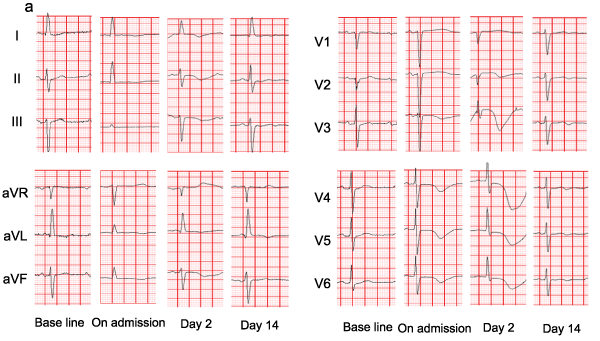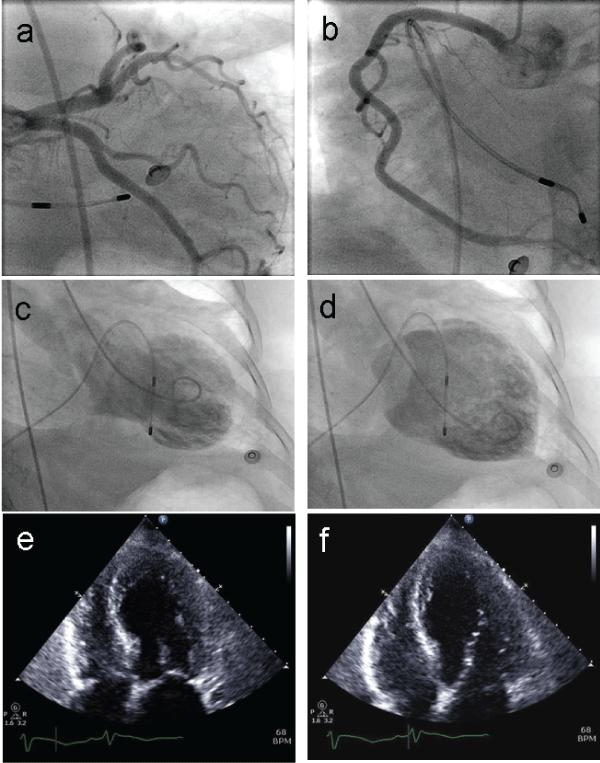International Journal of Clinical Cardiology
Takotsubo Cardiomyopathy Associated with Prolong QT Interval and Ventricular Tachyarrhythmia
Dhavalkumar Patel1* and Rajendrakumar Patel2
1Department of Cardiology, Virginia Commonwealth University, USA
2Department of Internal Medicine, Mercer University School of Medicine, USA
*Corresponding author: Dhavalkumar Patel, VCU School of Medicine, Department of Cardiology, PO Box 980509, Richmond, VA- 23298-0509, USA, Tel: 267-226-3733, Fax: 804-628-2436, E-mail: dr_dhavalpatel@yahoo.com
Int J Clin Cardiol, IJCC-2-028, (Volume 2, Issue 2), Case Report; ISSN: 2378-2951
Received: March 23, 2015 | Accepted: April 10, 2015 | Published: April 13, 2015
Citation: Patel D, Patel R (2015) Takotsubo Cardiomyopathy Associated with Prolong QT Interval and Ventricular Tachyarrhythmia. Int J Clin Cardiol 2:028. 10.23937/2378-2951/1410028
Copyright: © 2015 Patel D, et al. This is an open-access article distributed under the terms of the Creative Commons Attribution License, which permits unrestricted use, distribution, and reproduction in any medium, provided the original author and source are credited.
Abstract
Takotsubo Cardiomyopathy (TCMP), also known as apical ballooning syndrome or stress induced cardiomyopathy, is characterized by left ventricular mid and/or apical wall motion abnormality in the absence of obstructive coronary artery disease. TCMP is a disorder of left ventricular myocardial contractility, and rarely associated with serious cardiac conduction abnormalities. We reported a case of 80-year-old female who developed transient AV block, bradycardia and ventricular tachycardia in presence of long QT associated with TCMP, which was treated temporary venous pacing. After 3 months of follow up, she remained symptoms free and LVEF was normalized on repeat echocardiogram. TCMP can be considered a transient insult on myocardial repolarization caused by autonomic function disturbances and it causes TdP in presence of predisposing factors such as cardiac conduction anomalies, bradycardia, metabolic disease, medications, and genotype abnormalities. Research is warranted to examine outcome of TCMP patients with prolonged QTc interval.
Keywords
Takotsubo cardiomyopathy, Prolonged QTc, Torsade de pointes
Introduction
Takotsubo Cardiomyopathy (TCMP), also known as apical ballooning syndrome or stress induced cardiomyopathy, is characterized by left ventricular mid and/or apical wall motion abnormality in the absence of obstructive coronary artery disease [1-3]. TCMP is frequently precipitated by stressful events. The clinical presentation is often indistinguishable from acute coronary syndrome (ACS), and 2.2% of patients with an initial diagnosis of ACS are subsequently diagnosed with TCMP [2]. EKG findings typically include ST, T wave changes and a prolonged QTc interval [2-4]. Although, long QT is a typical finding of TCMP, it is certainly not diagnostic or pathognomonic. The natural history of TCMP is benign, and LV systolic dysfunction is usually reversible, requiring only supportive treatment until LV function normalizes [2]. Here, we report a case of TCMP-associated with prolonged QTc interval associated with bradycardia, transient AV block and subsequent torsades de pointes (TdP).
Clinical Case
An 80-year-old female with a medical history of hypertension presented with worsening of dyspnea, cough and bilateral leg swelling for three days. Her blood pressure was 220/116mmHg; the remaining vital signs were stable. Physical examination revealed bilateral crackles and pedal edema. Electrocardiogram (EKG) revealed nonspecific T wave changes and prolonged QTc interval (680ms) (Figure 1,2). Laboratory findings included mild elevation of Troponin-I (0.199, normal: 0-0.12ng/ml) and CK-MB (3.4, normal: 0-2.4ng/ml) and BNP (1170, normal: 0-99pg/ml).

.
Figure 1: EKG changes over time: Note the gradual prolongation of QTc interval at day 2; at Base line - 430ms, on admission - 680ms, on day 2 - 801ms, and on day 13- 470ms
View Figure 1

.
Figure 2: a & b) Non obstructive left and right coronary arteries; c & d) Ventriculogram in systole and diastole showing akinetic anterior and inferior wall and hyperkinetic base; e & f) four chamber echocardiographic views in systole and diastole showing wall motion abnormalities
View Figure 2
She developed hypoxic respiratory distress requiring intubation within few hours of admission. Telemetry revealed non-sustained ventricular tachycardia. EKG showed widening of the QRS complex (122ms) with a left bundle branch block (LBBB) pattern, T wave inversion, and prolonged QTc interval. Troponin-I and CKMB peaked at 3.02ng/ml and 7.0ng/ml respectively. Based upon the above findings, immediate cardiac catheterization was done, which revealed normal coronary arteries and ventriculography showed an akinetic apex and mid ventricular portion and a hyperdynamic base, findings consistent with Takotsubo cardiomyopathy (TCMP). During cardiac catheterization, the patient developed transient complete heart block requiring temporary venous pacing. She was transferred to the coronary care unit where EKG showed reversal of the complete heart block but persistent bradycardia and associated prolonged QTc interval. Echocardiogram revealed left ventricular ejection fraction (LVEF) of 25% and wall motion abnormalities consistent with TCMP.
The progressively lengthening QTc interval resulted in an episode of ventricular tachycardia consistent with torsade de pointes (TdP) for which she received electronic cardioversion. Additionally, right ventricular pacing was initiated at the rate of 90-beats/minute and continued for two days. She was also given prophylactic lidocaine for ventricular tachycardia, which was discontinued the next day.
No more episodes of ventricular tachycardia developed while on temporary ventricular pacing. However, on day 2, she developed cardiogenic shock and required dopamine infusion and Intra-aortic balloon pump (IABP). IABP was also discontinued on day 4 and she was extubated on day 5. Repeat echocardiogram showed improvement in LV function (LVEF 35%). QTc interval was monitored throughout her hospital stay and it was normalized upon discharge. The patient remained symptoms free and LVEF was improved to 55% on repeat echocardiogram after 3 months.
Discussion
Patients with TCMP have T-wave inversion and QTc prolongation during the early phase, but they can last for several weeks [4]. In a review of seven case series involving 180 cases, Bybee et al. reported a 1.5% incidence of ventricular arrhythmias among TCMP patients [3]. TCMP can be considered a transient insult on myocardial repolarization caused by autonomic function disturbances and it causes TdP in presence of predisposing factors such as cardiac conduction anomalies, long QT, bradycardia, metabolic disease, medications, and genotype abnormalities. Case series of TCMP-associated TdP reported a higher incidence of TdP in male patients with prolonged QT interval. In this case series, most patients (80%) had one or more risk factors for TdP including bradycardia with or without atrioventricular block, congenital long QT syndrome, hypokalemia, use of amiodarone and dysopyramide [5]. In our case, the patientís risk factors for TCMP-associated TdP included bradycardia and long QT.
Temporary ventricular pacing has been reported as an effective strategy for the treatment of TdP-associated with TCMP [5]. However, right ventricular pacing can cause LV dysynchrony, leading to worsening of LV function [6]. Indeed, in our case, the patient did not develop any episode of ventricular tachyarrhythmia on ventricular pacing but she developed cardiogenic shock requiring IABP in addition to vasopressors.
In patients with Takotsubo cardiomyopathy QTc interval prolongation is common and can last for more than two months. These patients should be discouraged to take medications that can prolong the QTc interval. While these patients are hospitalized, monitoring cardiac rhythm and electrolytes closely is critical to prevent ventricular arrhythmias. Further research is needed to elucidate which patients with prolonged QTc interval are at risk for TdP and to examine outcome of TCMP patients with prolonged QTc.
References
-
Kurisu S, Sato H, Kawagoe T, Ishihara M, Shimatani Y, et al. (2002) Tako-tsubo-like left ventricular dysfunction with ST-segment elevation: a novel cardiac syndrome mimicking acute myocardial infarction. Am Heart J 143: 448-455.
-
Gianni M, Dentali F, Grandi AM, Sumner G, Hiralal R, et al. (2006) Apical ballooning syndrome or takotsubo cardiomyopathy: a systematic review. Eur Heart J 27: 1523-1529.
-
Bybee KA, Kara T, Prasad A, Lerman A, Barsness GW, et al. (2004) Systematic review: transient left ventricular apical ballooning: a syndrome that mimics ST-segment elevation myocardial infarction. Ann Intern Med 141: 858-865.
-
Kurisu S, Inoue I, Kawagoe T, Ishihara M, Shimatani Y, et al. (2004) Time course of electrocardiographic changes in patients with tako-tsubo syndrome: comparison with acute myocardial infarction with minimal enzymatic release. Circ J 68: 77-81.
-
Samuelov-Kinori L, Kinori M, Kogan Y, Swartzon M, Shalev H, et al. (2009) Takotsubo cardiomyopathy and QT interval prolongation: who are the patients at risk for torsades de pointes? J Electrocardiol 42: 353-357.
-
Lupi G, Sassone B, Badano L, Peraldo C, Gaddi O, et al. (2006) Effects of right ventricular pacing on intra-left ventricular electromechanical activation in patients with native narrow QRS. Am J Cardiol 98: 219-222.





